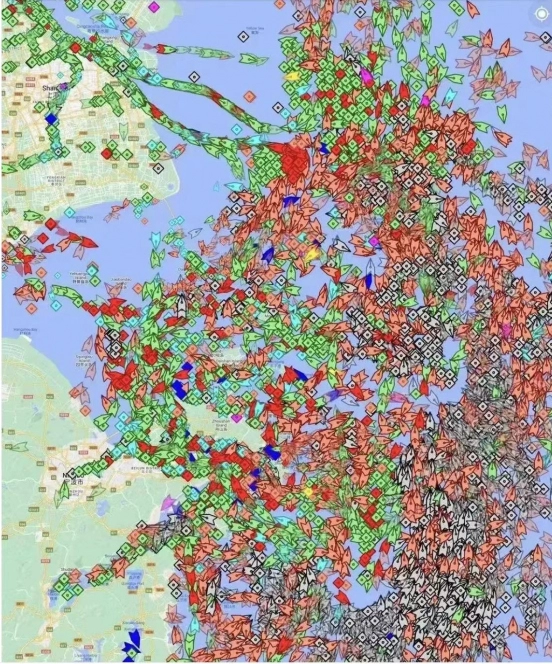Shanghai epidemic raises concerns about shipping
On April 2, Ye Xinran, a reporter from Economic Observer.com, showed a picture of a cargo ship docked on the seashore of Shanghai circulating on the Internet. The densely packed ship logos in the picture were densely covered in the waters around Shanghai, creating a visual impact on people. The sense of oppression conveyed to the outside world that the Shanghai port has experienced serious congestion. For a time, the picture quickly caused heated discussions on the Internet. Especially in the context of Shanghai's epidemic prevention and control, the topic of the impact of the Shanghai epidemic on shipping continued to attract attention and discussions.
Regarding the pictures uploaded on the Internet, Chen Yang, the relevant person in charge of Xinde Maritime, a maritime information consulting service agency, told reporters that the locations marked in the picture not only include Shanghai Port, but also Ningbo Zhoushan Port; moreover, the picture basically shows the large and small ships , including cargo ships, fishing boats, small tugboats, passing ships, and the residual signals of ships that have left are included.
Statistics show that Shanghai Port ranks first in the world in terms of annual container throughput, and Ningbo Zhoushan Port ranks first in the world in terms of annual cargo throughput. Therefore, the Yangtze River Estuary is an extremely busy waterway.
According to the reporter from the Economic Observation Network, the reporter learned from various interviews that the map covers a wide range of waters and cannot truly reflect the berthing situation of Shanghai Port. On April 2, SIPG also responded to the news of "severe congestion in Shanghai Port", saying that SIPG has taken strict precautions against the epidemic, the production and operation of the terminal are as usual, and there is no congestion of container ships.
However, according to the observation data of VesselsValue, in March, the number of various types of ships waiting in the waters near Shanghai did show an upward trend, especially in the middle and late March, showing a marked increase in the number of "dry bulk carriers, oil tankers" The number of ship berthings has increased significantly, and the number of container ships has declined.” According to statistics, from March 1 to March 30, the number of berthing ships in the waters near Shanghai increased by more than 70% year-on-year. In the past two days, the number has still increased.
Airlines have adjusted their business in Shanghai one after another, trucks are slow in customs clearance, and cargo transit is inefficient... Under the haze of the epidemic, whether Shanghai Port can continue to efficiently turn around is still a grim situation.
Steel, as a bulk commodity, bears the brunt of the impact. Many steel products are piled up in warehouses and cannot be shipped out on time, many steel products orders were out of delivery time.

Regarding the pictures uploaded on the Internet, Chen Yang, the relevant person in charge of Xinde Maritime, a maritime information consulting service agency, told reporters that the locations marked in the picture not only include Shanghai Port, but also Ningbo Zhoushan Port; moreover, the picture basically shows the large and small ships , including cargo ships, fishing boats, small tugboats, passing ships, and the residual signals of ships that have left are included.
Statistics show that Shanghai Port ranks first in the world in terms of annual container throughput, and Ningbo Zhoushan Port ranks first in the world in terms of annual cargo throughput. Therefore, the Yangtze River Estuary is an extremely busy waterway.
According to the reporter from the Economic Observation Network, the reporter learned from various interviews that the map covers a wide range of waters and cannot truly reflect the berthing situation of Shanghai Port. On April 2, SIPG also responded to the news of "severe congestion in Shanghai Port", saying that SIPG has taken strict precautions against the epidemic, the production and operation of the terminal are as usual, and there is no congestion of container ships.
However, according to the observation data of VesselsValue, in March, the number of various types of ships waiting in the waters near Shanghai did show an upward trend, especially in the middle and late March, showing a marked increase in the number of "dry bulk carriers, oil tankers" The number of ship berthings has increased significantly, and the number of container ships has declined.” According to statistics, from March 1 to March 30, the number of berthing ships in the waters near Shanghai increased by more than 70% year-on-year. In the past two days, the number has still increased.
Airlines have adjusted their business in Shanghai one after another, trucks are slow in customs clearance, and cargo transit is inefficient... Under the haze of the epidemic, whether Shanghai Port can continue to efficiently turn around is still a grim situation.
Steel, as a bulk commodity, bears the brunt of the impact. Many steel products are piled up in warehouses and cannot be shipped out on time, many steel products orders were out of delivery time.


